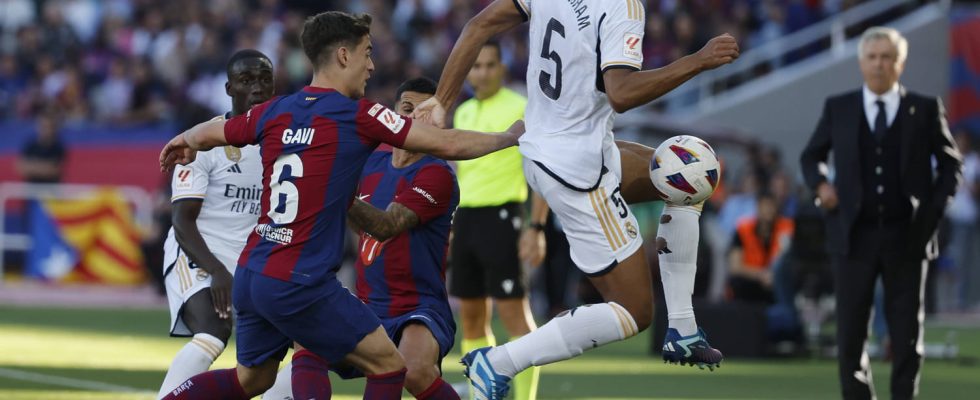The new Super League project combines excessive economic ambitions and the promise of better sporting fairness. What is it really?
Bernd Reichart, CEO of the company A22, promoter of the Football Super League, unveiled this Thursday, December 21, a new format for his competition project, which aims to compete with the Champions League and UEFA. This announcement follows the decision of the Court of Justice of the European Union, which deemed “illegal” the sanctions envisaged by FIFA and UEFA in the event of the organization of such a competing competition. What would this new European competition look like, promising matches broadcast for free and greater sporting fairness?
“For the first year of the competition, clubs will be selected on the basis of a set of transparent and performance-based criteria” first promises the company A22. The Super League project presented offers two versions, one for men and the other for women. In its men’s version, the competition brings together 64 clubs, divided into 3 divisions: the Star League, the Gold League and the Blue League, in descending order of level. Has the promise of greater sporting fairness of this new format, which aims to convince all the players in European football, really been kept?
More matches for more revenue
The first two divisions will be made up of 16 clubs and divided into two groups of 8 teams. Each team will face the other seven in its group in two-way matches, guaranteeing 14 additional matches for each club, compared to 8 for the new version of the Champions League, which will see the light of day next year. The Blue League, the third division of the pyramid, will be made up of 32 clubs, divided into 4 groups of 8 teams competing on the same basis.
After this group stage, classic final stages (direct elimination) will see the best teams from each group compete for the title: the four best teams from each group will qualify for the quarter-finals in the Star League and Gold League. , the two best in the Blue League. Participation in the Super League will add at least 14 matches per season to the schedule of the teams concerned, and up to 19 matches. The meetings will take place during the week, in parallel with the national championships. There will also be knockout matches for relegation or promotion from one division to another.
Only two relegations and promotions are planned per division each season, with the exception of the Blue League which will allocate 20 of its places based on the results of the national championships. This nevertheless means that a team not qualified in the first year will have to qualify for the Blue League via its championship, then finish in one of the first two positions (out of 32) to access the Gold League, then again finish in the one of the two first positions (out of 16) to finally reach the elite, the Star League.
It will therefore take at least three years to reach the best European competition via its national championship. This system is in fact designed to protect the big clubs, who will be almost guaranteed their place in the Star League once it is acquired, unless they finish in one of the last two places. Above all, the national championships will radically lose their interest for these clubs, especially since they will not guarantee a direct place in the Star League but only in the Blue League, the third level of the pyramid.
A reduced women’s version, all matches visible for free
In the women’s version, only 32 teams will compete in these competitions. They will be divided into two divisions, the Star League and Gold League, in formats similar to the men’s version. A promotion-relegation system would see an annual rotation of four teams between the Star League and the Gold League, and between the Gold League and the national championships.
A22 CEO Bernd Reichart said that “all matches and match highlights will be available for free” via a dedicated streaming platform called Unify and funded through advertising. For clubs, it promises higher income than current European competitions, but also “solidarity payments” of at least 400 million euros annually to European football.
Men’s version of the Super League:
Star League (division 1): 16 teams
- 2 groups of 8, home and away matches
- Top four from each group qualified for the final phase
- Quarter-finals, semi-finals, final
- 2 relegations to the Gold League
Gold League (division 2): 16 teams
- 2 groups of 8, home and away matches
- First four from each group qualified for the final phase
- Quarter-finals, semi-finals, final
- 2 promotions in Star League, 2 relegations in Blue League
Blue League (division 3): 32 teams
- 4 groups of 8, home and away matches
- Top two from each group qualified for the final phase
- Quarter-finals, semi-finals, final
- 2 promotions to the Gold League, 20 places according to the results of the national championships
Women’s version of the Super League:
Star League (division 1): 16 teams
- 2 groups of 8, home and away matches
- Top four from each group qualified for the final phase
- Quarter-finals, semi-finals, final
- 2 relegations to the Gold League
Gold League (division 2): 16 teams
- 2 groups of 8, home and away matches
- Top four from each group qualified for the final phase
- Quarter-finals, semi-finals, final
- 2 promotions in Star League, 4 places according to the results of the national championships
